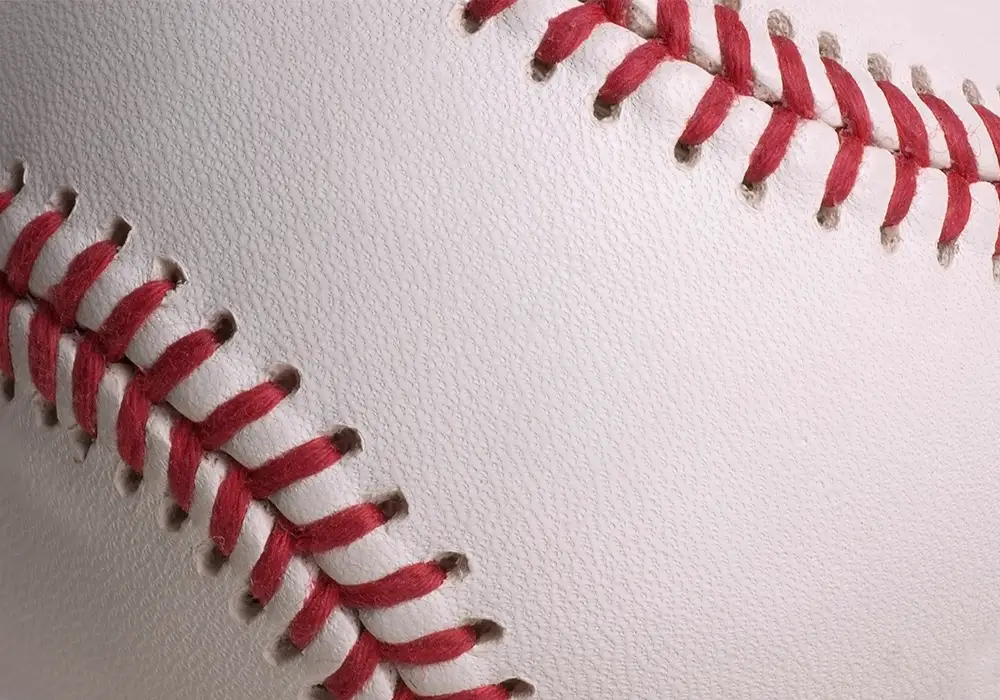How Many Stitches on a Baseball?
Baseballs are an iconic part of American culture, and it’s their simple yet durable design that has endured technical advancements for generations. Baseballs are still made mostly by hand, including the stitching.
Traditionally, there are 108 double stitches that hold the baseball together. Of these stitches, the first and last ones are invisible as they are hidden. The thread itself is 88 inches long and is made of waxed red thread.
Why are baseball stitches red?
It’s hard to imagine a baseball being stitched with anything other than red thread. Baseballs have habitually maintained this color scheme for generations. However, despite being sewn together with red thread for decades, there isn’t much of a reason why baseball stitches are red. The red thread used might be done so out of tradition, but some speculate that it’s easier to see the ball if there’s a contrast between the colors of the casing and the thread.
What are baseballs made of?
Whilst the technique of making baseballs has stayed the same for years, the actual materials used have changed over time to become much safer and cheaper to produce.
Baseballs are made up of several different materials, such as cowhide, rubber, cork, and yarn. The cowhide makes up the casing of the ball, whilst rubber coats the cork that’s encased in the center. The yarn is wrapped around the center to keep it in place and to ensure that the ball isn’t hollow. There are different densities of yarn used in each ball to ensure they are weighted and play the same.
Whilst these are the modern materials used to make baseballs, traditionally they were made of horsehide and solid rubber. Horsehide was ditched as late as 1974 in favor of the cowhide skins, whereas the solid rubber center became rubber-coated cork in 1910.

How are baseballs made?
Traditionally, baseballs were made by hand, and continue to be done so today despite efforts to modernize the production.
Official MLB balls are made by Rawlings, and are produced in Cuba. The materials to make them are exported from the United States to be made into balls, and then imported back once they are manufactured.
The rubber and cork core of the ball is one of the only aspects that is machine-made, but things like the stitching and general assembly of the ball are completed carefully by hand. Baseballs must look and feel identical to each other at the end of production, as even a minor defect can change the dynamics of the ball. For instance, a baseball needs to weigh between 5 and 5 ¼ ounces, and have a circumference of 9 to 9 ¼ inches for it to be legal to use in an MLB game.
Why are baseballs replaced during a game?
In an average game of baseball, 120-144 balls are used. There are a plethora of reasons why balls are replaced so flippantly during a game of baseball, which include them being scuffed (usually by the batsman), or damaged in another way by either the pitcher, batsman or another field member. If the baseball is deemed to be damaged by the umpire, it can also be thrown out.
Regardless of whether the ball is damaged or not, it can be forcibly removed from play by the rules in place. One such example is that a ball cannot be retrieved once it has left the field. The pitcher is also allowed to request a new baseball at any point, thus having the previous one thrown out. These are just a few examples as to why baseballs are replaced during a game. Other examples are explored in how many balls are used in baseball.
On the contrary, some balls never even make it into the game, usually because they were bought in excess. In such cases, they can be donated to other leagues or kept aside to use in a future game.
What is the cost of new baseballs each year?
Due to the aforementioned nature of baseball, it’s impossible to accurately predict how many baseballs will be used on the field as they can be disused for any minor defect or scuff. As a result, the cost of new baseballs each year can change between seasons, but usually remains high as a way to meet the demands of the sport.
MLB baseballs are usually bought in bulk due to the demand during matches, and are often around $7-$10 each. Each season usually goes through just under 1,000,000 balls, so up to $10million is spent, which means the league usually spends over $10,000,000 per annum on balls alone.
A brief history of baseball stitching
Baseballs are recognizable for their iconic figure 8 design, which is believed to be the most durable and cost-effective technique to create baseballs. The initial creator of the figure 8 design is largely disputed, but fans believe either Ellis Drake, the son of a shoemaker, was the first to come up with the design, whilst others believe that Colonel William A. had created the product and sold it to William Harwood, who was the first to own a baseball factory and popularised the production process of the quintessential figure 8 baseballs.
The stitched balls for MLB are still mostly hand made by their manufacturer Rawlings, and it’s believed one reason why they are still made by hand is that the desired effect is too complicated to produce with machinery.
